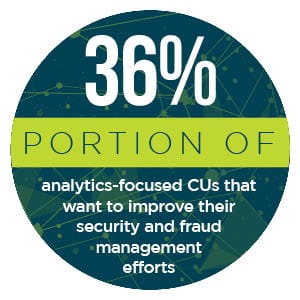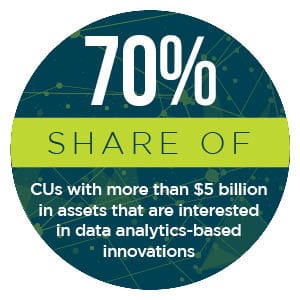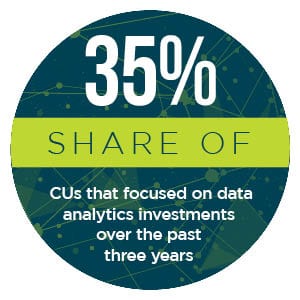
In the financial services industry, knowledge is power. For credit unions (CUs), data analytics can deliver that insight, helping them to more effectively address their members’ specific needs, and informing CUs of the products and services that can deliver the most effective returns on their investments.
 In fact, credit unions that focus on data analytics are more likely to pursue a wider range of innovations than those that do not. For example, 91.7 percent of those focused on data analytics said they also focused on fraud management solutions in the previous three years, compared to only 60.6 percent of CUs that did not focus on data analytics. Meanwhile, 80.6 percent of CUs that focused on data analytics also focused on real-time payments, compared to 66.7 percent of CUs that did not focus on data analytics.
In fact, credit unions that focus on data analytics are more likely to pursue a wider range of innovations than those that do not. For example, 91.7 percent of those focused on data analytics said they also focused on fraud management solutions in the previous three years, compared to only 60.6 percent of CUs that did not focus on data analytics. Meanwhile, 80.6 percent of CUs that focused on data analytics also focused on real-time payments, compared to 66.7 percent of CUs that did not focus on data analytics.
Yet, only about one-third of CUs have made investing in data analytics a top priority. Instead, most are focusing on improving their anti-money laundering (AML), data security, mobile and digital payments, and anti-fraud operations. As it turns out, though, data analytics and security often go hand in hand, as 36.4 percent of CUs that focused on data analytics said they did so to secure their operations.
The latest edition of the Credit Union Innovation Playbook — a collaboration between PYMNTS and PSCU — analyzes the key factors incentivizing some CUs to make data analytics a top investment priority, even while competitors shift their attention elsewhere. The results are based on insights from 102 credit union decision-makers, and highlight how CUs that focus on data analytics are more likely to pursue innovations than those that do not.
 Some CUs are much more likely to pursue innovations than others. According to PYMNTS’ research, budgeting is one of the biggest barriers preventing CUs from investing in data analytics solutions.
Some CUs are much more likely to pursue innovations than others. According to PYMNTS’ research, budgeting is one of the biggest barriers preventing CUs from investing in data analytics solutions.
Credit unions with assets that range from $1 billion to more than $5 billion are more likely than others to make data analytics a top investment priority. These larger CUs are also more likely than their smaller counterparts to invest in AML, data security, mobile and digital payments, and fraud-fighting solutions. Of course, with larger assets available to them, these CUs are better able to pursue innovations.
These are just a few of the findings outlined in the Playbook. Other notable findings include:
Download the Playbook to find over 200 data points, highlighting how data analytics is informing a wide range of innovation priorities in the credit union market.
About the Playbook
The Credit Union Innovation Playbook, in collaboration with PSCU, delves into the innovation agendas of players in the credit union ecosystem. Each edition of the Playbook hones in on a specific innovation focus, exploring the differences between how credit union members and leaders prioritize innovation in four select areas: risk and fraud, digital banking, data and analytics, and loyalty.